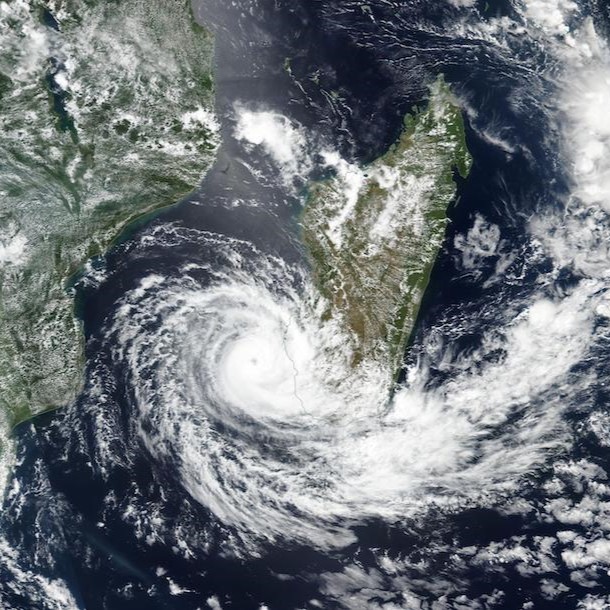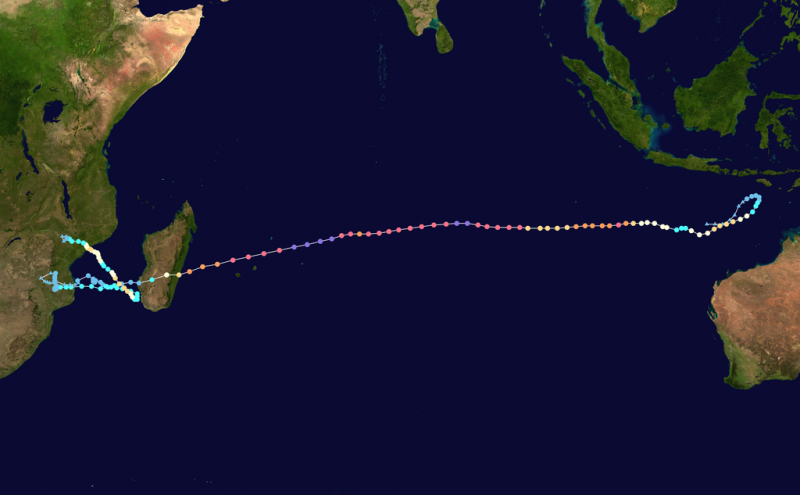
Tropical Cyclone Freddy sets new record
On February 5, 2023, Tropical Cyclone Freddy formed in the eastern Indian Ocean near northern Australia. From the beginning, the cyclone appeared formidable on satellite images as it headed west. It then traversed the entire Indian Ocean over the course of a month. And now – on March 14 – Freddy is still active. It has raged for 37 days, setting a new record as the world’s longest-lived tropical cyclone.
It easily beat out Hurricane John (1994), which lasted for 31 days in the Pacific Ocean. And John had surpassed both 1992’s Hurricane Tina in the Pacific (24 days), as well as the 1899 San Ciriaco hurricane’s previous world record of 28 days in the 1899 Atlantic season.
Freddy was only the 4th known cyclone to travel the Indian Ocean from east to west. The powerful and now-deadly storm made landfall on Madagascar on February 21, then crossed over the Mozambique Channel before making landfall in Mozambique. It returned to the channel on March 1, brushing Madagascar again and then returning to Mozambique for a second landfall.
As Freddy churned over this region of Africa, it produced copious rainfall, deadly flooding and mudslides. As of March 14, 2023, more than 200 people have died from Freddy.
Freddy was equivalent to a Category 5 hurricane
Freddy also set a record for the highest accumulated cyclone energy (ACE) of any tropical cyclone in the Southern Hemisphere. At its strongest, Freddy was equivalent to a Category 5 Atlantic hurricane with winds more than 160 miles per hour.

Cyclone Freddy has been raging in the Indian Ocean for almost an entire month straight, making it one of the longest-lasting storms of its kind in recorded human history pic.twitter.com/sUqtOua2EN
— NowThis (@nowthisnews) March 9, 2023
Believe it or not, these two satellite images of Cyclone Freddy were taken 20 days apart. pic.twitter.com/0A2Q9kjIiF
— Nahel Belgherze (@WxNB_) March 11, 2023
Freddy’s disastrous effects in Africa
Freddy caused death and destruction everywhere it hit. The current death count stands at 17 people in Madagascar, 20 in Mozambique, 2 in Zimbabwe and 190 in Malawi. The flooding in Malawi was particularly severe in Blantyre, the country’s second-largest city.
Impact of Tropical Cyclone Freddy being felt. Water levels are high in most southern districts' rivers. Below is Thuchira River at Kambenje, the boundary between Mulanje and Phalombe districts, down stream is flooding already, as the rains associated with wind continue pouring. pic.twitter.com/sVg82ODZ1e
— Malawi Red Cross Society (@MalawiRedCross) March 12, 2023
#BreakingNews; Malawi Has Suspended Schools as Cyclone Freddy Kills 40 People
In one of the photos below, people in Malawi look at a collapsed road caused by flooding due to heavy rains following Cyclone Freddy in Blantyre, Malawi, on March 13, 2023.#climatechange pic.twitter.com/gOzwyrJOeT
— Africa Global News (@Africaglobalnew) March 14, 2023
#UPDATE At least 190 people have died in Malawi since Cyclone Freddy smashed into southern Africa at the weekend, triggering flooding and mudslides, Malawian authorities said on Tuesday ?? https://t.co/ZlLHdY2qgx pic.twitter.com/IowPxLwiJU
— AFP News Agency (@AFP) March 14, 2023
Bottom line: Tropical Cyclone Freddy has easily set a new record as the world’s longest-lived cyclone. It has killed more than 200 people in Africa.
Read more: Global warming is making hurricanes stronger
The post Tropical Cyclone Freddy sets world record for longevity first appeared on EarthSky.
0 Commentaires